We met Yavar the first day we were to move into our apartment in Barcelona last summer. We were standing outside his restaurant waiting for the rental agency to show up. He started speaking to us in English and we have been friends ever since. Yavar invited us to come to Azerbaijan while he was there this spring and stay at his parents house. He offered to show us his city of Baku and his country. We thought probably no one is ever going to invite us to Azerbaijan again so we better go.
There is a novel “Ali & Nino” by Kurban Said that is a love story between a Georgian Christian woman and Azerbaijani Muslim man that takes place in 1918-1920. It explores the political, geographic and religious divides that this couple faced. It has also been made into a movie recently and was filmed on location. It gave us some good insight of the culture we were about to visit.
This part of the Caucasus region has a long and fascinating history. Azerbaijan became the first democratic state in the Muslim-oriented world in 1918. It was incorporated into the Soviet Union in 1920 and finally regained its independence in 1991. It is in the south Caucasus region bordered by Russia on the north, the Caspian Sea on the east, Iran on the south, Armenia to the west and Georgia to the northwest. It is an oil rich country with a high level of literacy and economic development.
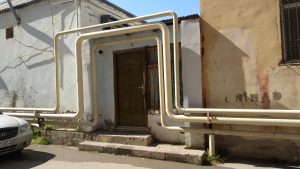
So we flew to Baku on April 14th and were met at the airport by Yavar’s brother-in-law Ahmed. Yavar had told us he was going to be attending a wedding this day but he would make sure we were picked up. Ahmed took us to their house where we were welcomed by Yavar’s sister and mother, Natawan and Ellada. They had prepared an entire coffee table full of cakes, baklavas, dried fruits and chocolates for us to snack on before dinner! Before long, his father, Sayfalla arrived home and we were served dinner. The thing I remember the most was the rice pilaf. It was so fragrant and rich that it tasted like a cake to me! It had a crunchy caramelized layer at the bottom that was superb. Someday I hope I can learn to make this dish.
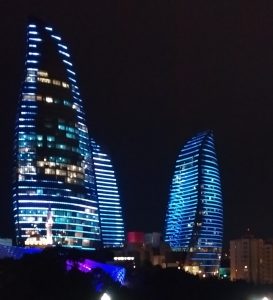
After the food had settled a bit Ahmed, Natawan and their two-year old daughter drove us to see the city center of Baku. It is really something you have to see at night. The three flame towers are illuminated with more than 10,000 LED lights. They are constantly changing from looking like flames, to the blue, red and green of the national flag, to other designs. They are the tallest buildings in the city center and can be seen from a long way off.
Our first full day there was spent visiting the old part of town with Yavar. We visited the carpet museum which looked like a big rolled up carpet. It was very informative and well-organized. In the evening he took us to a revolving bar/restaurant on the top of the Hilton hotel. There were a few other buildings with interesting illumination and this was a great way to enjoy the skyline.
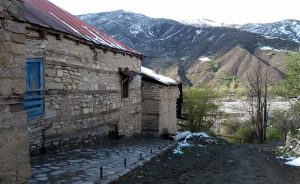
The next day Yavar’s parents came along with us on a drive up north to the Caucusus mountains where we visited the Shamakhi Astrophysical observatory. There we learned about the scholar Nasir al-Din al-Tusi (sometimes written as Nasreddin Tusi), born in 1201 who is often considered the creator of trigonometry. He helped build an observatory in Azerbaijan in the middle of the 13th century.
We then took a winding dirt road to Lahic, a village that was founded about a thousand years ago by people from the southern part of what is now Iran. They spoke the Tat language which is only spoken here. Yavar said he didn’t understand it very well and he is a man of many languages. This village is known for its copper smiths. There had been snow recently and the melting snow was forming a little river down the middle of the street we were exploring.
Next we headed to Gabala also known as Qabala. It is a popular tourist destination because of its natural beauty and interesting history as the former capital of Caucasian Albania, (not to be confused with modern-day Albania). We stopped at the Tufandag Ski Resort for dinner just as the sun was going down. Unfortunately, after dinner it was time to return to Baku. I would have liked to have spent more time exploring this area. 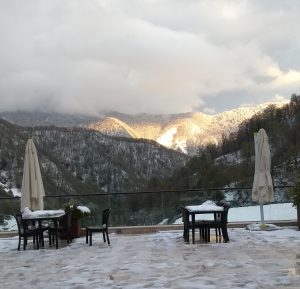
The next day we took a short drive to Gobustan, a UNESCO World Heritage Site. It is a natural area with many petroglyphs that can be easily seen by following a short trail. We could see the beautiful turquoise waters of the Caspian Sea in the distance. There was an option to go see some mud volcanoes while we were there. So we hired a driver to take us in a beat up old Russian Lada the 3 km over a rough dirt track. The volcanoes were cones about 10-15 ft. high with gently bubbling cool, grey mud overflowing down the sides. They are not caused by magma but escaping gas. Occasionally they are a little explosive, but the ones we saw seemed pretty harmless at the moment. Azerbaijan has long been known as the land of fire for the burning gas escaping through fissures in the ground. Some people believe that Azerbaijan was the birthplace and inspiration for Zoroastrianism.
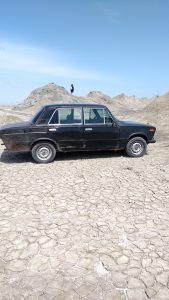
The Absheron peninsula where Baku is located is mostly desert. There are many oil derricks once you get outside Baku. But the north coast of the peninsula along the Caspian Sea has many vacation homes and little restaurants lining the beach. We went to one of these for lunch the next day and had some scrumptious camel meat turnovers and soup served in little clay vessels. We returned to Yavar’s parents house for an afternoon tea that involved firing up a samovar out on the patio. We had a memorable afternoon sitting in the sun drinking tea and eating cakes with Yavar’s entire family.
Our last day in Azerbaijan was spent driving up the coast of the Caspian Sea to the town of Quba. It was a beautiful drive as the area has many apple orchards and they were in full bloom. The snow-capped Caucasus provided a nice background too. A unique baklava that is spelled “paxlova”, is produced there.
Yavar kept driving higher and higher up into the mountains until he pointed out the village Khinalug across the valley. He said it was one of the highest villages in the country. With a history spanning some 5000 years, it is also one of the oldest continuously occupied communities on earth. It was near here where we turned around and came back to Quba. We stopped at a roadside restaurant for some lunch where there was a couple making meat or herb filled turnovers on a griddle. The woman had a striking set of all gold teeth and the turnovers called gutab were so good!
That evening when it was time to go, Yavar and his mom, Ellada drove us to the train station. We had time for a last cup of tea with them. They accompanied us on to the train to see that we were settled and explained to the porters that we didn’t speak Azerbaijani. We were so grateful for their hospitality it was sad to say goodbye!
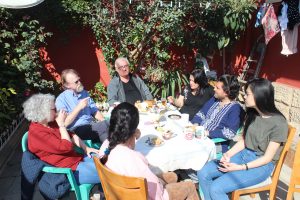
Check back to read our next post about the trip to Georgia.
What a delightful journey! Thanks for sharing.